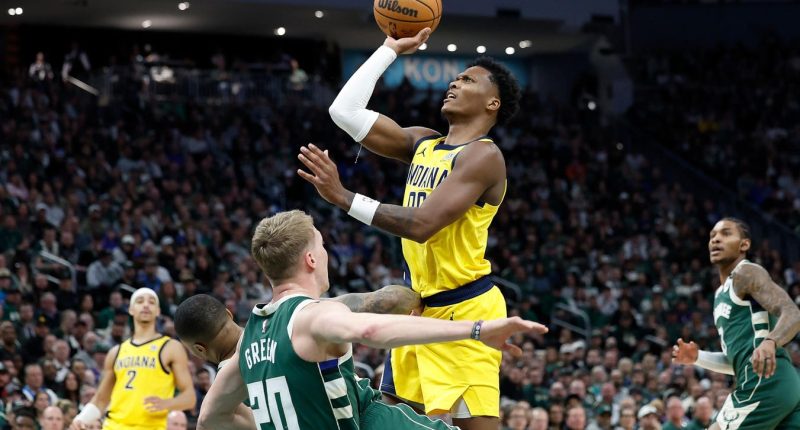Share this @internewscast.com
MILWAUKEE, WISCONSIN – APRIL 25: Bennedict Mathurin #00 of the Indiana Pacers is fouled going up for … More
Getty Images
MILWAUKEE – With five minutes to go until halftime of Game 3 in the Indiana Pacers vs Milwaukee Bucks first-round playoff series, the Bucks were ahead 39-38. It was a choppy game to that point with both teams missing threes, but Indiana was about to go on a run. The visitors finally erupted to close the second period, carrying a 57-47 lead into halftime.
It felt like a huge moment for the blue and gold, who led the series 2-0 at the time. Yet four minutes of game action later, the game was tied. Before the third quarter ended, the Bucks were the team up double digits. Milwaukee’s lead reached 20 near the middle of the final frame.
It was a 30-point swing in about 18 minutes of play. The Pacers looked out of sorts and had to figure out what exactly just happened to them. Where did their lead go? Why did they look so hopeless after a promising surge going into halftime?
“We were bad on both sides of the ball. They were great, we were bad,” Pacers head coach Rick Carlisle said of the second half.
What went wrong for the Pacers?
The Pacers were poor on both ends in the second half on Friday night. It cost them the game, though it may be easy for the blue and gold to shrug it off as one half of one game. But they can’t do that. Two-way struggles are concerning and show that the Pacers must be better to win the series.
On offense, the Pacers were slowed – both in scoring and in tempo. Indiana takes pride in their pace and movement. They often generated quality shot attempts in the first two games of the series. Yet in the second half of Game 3, they couldn’t. Many of their scoring possessions ended with one-on-one play rather than a shot created by ball movement. They were taking too much time finding space that the shot clock became another defender.
During the regular season, the Pacers only had an offensive pace number (seconds per possessions) above 15 on 10 occasions. In the postseason, it’s happened in all three games so far. They’ve been unable to find clean looks early in possessions, though it wasn’t a problem in the first two games of the series. In Game 3, Milwaukee’s defensive pressure rose. It got the Pacers out of their rhythm and slowed the game down.
The blue and gold were seeing more switching from the Bucks. That isn’t new – the Pacers have seen swithcing defenses before, even from Milwaukee in this very series. But on Friday, with a new starting lineup for the Bucks and less connected play from Indiana, that switching was more effective. With the Pacers halted and their options less appealing, they scored just 44 points in the second half of Game 3 – lowlighted by an 18-point second quarter. They couldn’t find high-quality attempts.
“I thought our half-court offense got a little stagnant. We were playing on our heels,” Pacers guard Tyrese Haliburton said. “It starts with me. We’ve got to do a better job getting downhill from the jump.”
Indiana scored 31 points in the second quarter of Game 3. They didn’t reach 31 points in the second half until the clock read 4:37 in the fourth quarter – it took almost 20 minutes of action. The team needs to recapture their tempo against switching defenses and not get stagnant in coming games. Mismatch hunting has to be a last-ditch option.
Points come easy for the Pacers when they get stops and run in transition. Another way they can up their scoring numbers from the second half of Game 3 would be by improving on the defensive end. But Indiana struggled on that side of the ball Friday night, too. In tandem, they were crushed.
Milwaukee Bucks guard Damian Lillard, left, guards against Indiana Pacers forward Aaron Nesmith, … More
Copyright 2025 The Associated Press. All rights reserved.
The Bucks put 39 points on the scoreboard in the third quarter, their highest scoring frame of the series by six points. They followed it up with 31 in the fourth period, ending the second half with 70 tallies on the scoreboard. They previously hadn’t climbed over 60.
Indiana couldn’t stop a thing. Giannis Antetokounmpo, the primary defensive focus for the Pacers, scored 20 points and shot 70% in the half. Slowing him is nearly impossible, but the Pacers want to make his life difficult. They didn’t in that half, and Antetokounmpo had four assists on top of his scoring.
Because the two-time MVP is so threatening, the blue and gold send unique coverages and double teams his way. It’s important that they rotate out of those looks quickly to stop other players, but even that was a chore in the second half Friday. Pacers star forward Pascal Siakam shared after Game 1 of the series that his team needs to be better getting out to shooters. It finally caught up to them in Game 3.
“We messed up a few coverages, weren’t solid enough on that side of the floor,” guard Andrew Nembhard said of the team’s defensive struggles. “We’ve just got to stay solid and stick to our plan.”
The Pacers didn’t rotate well on defense, and the Bucks capitalized on their open long-range attempts. They shot 11/18 from beyond the three-point arc with Gary Trent Jr making seven of those triples alone. Trent Jr alone scored as many points as the entire Pacers team in the third quarter of the game.
“We had a couple miscommunications that led to some open [shots]. He got hot,” Haliburton said of Trent’s shooting.
With Game 4 coming soon, Indiana has to work out the kinks they showed in the second half of Game 3. There was clear, emotive frustration during the two-quarter disaster, and the Pacers need to show improvement before the best-of-seven heads back to Indianapolis this week.
After early-series success, the Bucks narrowed the gap between themselves and the Pacers on Friday. Now, Indiana is the team looking to respond. “I think adversity is good in a playoff series,” Pacers center Myles Turner said. “I’m glad that we are kind of looking it in the face now.”







